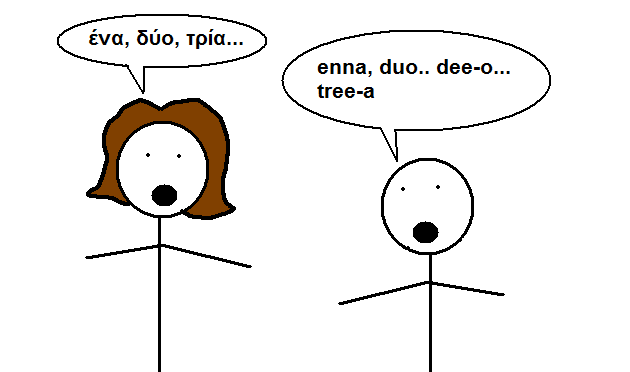This is the first in a series of Classical Greek lessons I am compiling.
The Greek alphabet consists of 24 letters, of which 19 were adapted from the Phoenician alphabet. The Latin alphabet is thought to have evolved from a variant of the Greek alphabet, and therefore there are many letters that have similarities between the Greek and Latin alphabets. The following is a list of the letters of the Greek alphabet, their name and Latin “equivalent” commonly used in transliteration.
| Letter | Name | Tansliteration | |
| Α | α | alpha | a |
| Β | β | beta | b/v |
| Γ | γ | gamma | g/ng |
| Δ | δ | delta | d |
| Ε | ε | epsilon | e |
| Ζ | ζ | zeta | z/dz/zd |
| Η | η | eta | e/i |
| Θ | θ | theta | th |
| Ι | ι | iota | i |
| Κ | κ | kappa | k |
| Λ | λ | lambda | l |
| Μ | μ | mu | m |
| Ν | ν | nu | n |
| Ξ | ξ | xi | ks |
| Ο | ο | omicron | o |
| Π | π | pi | p |
| Ρ | ρ | rho | r/rh |
| Σ | σ/ς | sigma | s |
| Τ | τ | tau | t |
| Υ | υ | upsilon | y/u |
| Φ | φ | phi | ph/f |
| Χ | χ | chi | ch/kh |
| Ψ | ψ | psi | ps |
| Ω | ω | omega | o |
Going into the topic of Greek pronunciation is complicated, especially when talking about Ancient Greek. The way the Greek language is pronounced has changed over the past thousands of years, and therefore, the modern Greek pronunciation is different than that of the ancient periods. We don’t know how ancient Greek was exactly pronounced, however, there are attempts at reconstructing the old pronunciation that give us an estimate of how the language was spoken.
Another thing to keep in mind regarding Greek pronunciation is that several of its letters will have different sounds associated to them depending on their position in a word (i.e. preceding or following letters). I won’t go over the pronunciation over text. Instead I’ll save that for a future date when I have enough resources to record audio for it.
You’ll notice that the letter sigma (Σ, σ, ς) has two different forms for the lowercase. The ς form is used when the letter is at the end of a word, and the σ form is used in all other instances. Another way of writing sigma is using the lunate sigma, ϲ, but this form is not as common today as it once was.
The letter gamma (Γ, γ) has two different transliterations, g and ng. Alone, this letter is almost always transliterated as g. But in cases where a double-gamma is present (γγ), the letter is transliterated as ng to represent a nasal sound.
